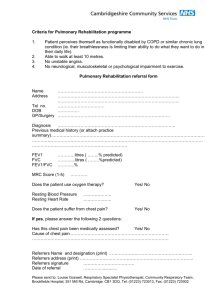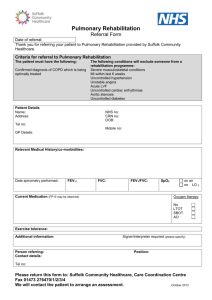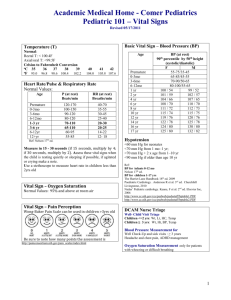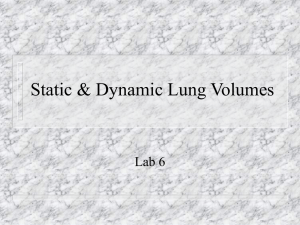Errors in the measurement of vital capacity
advertisement
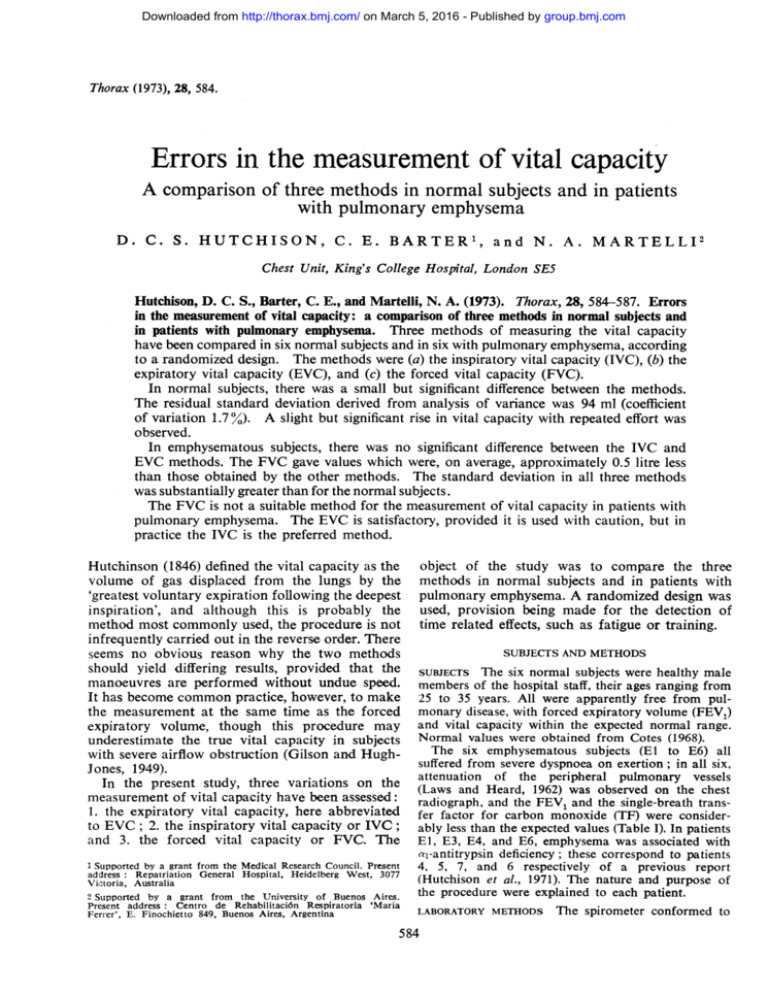
Downloaded from http://thorax.bmj.com/ on March 5, 2016 - Published by group.bmj.com Thorax (1973), 28, 584. Errors in the measurement of vital capacity A comparison of three methods in normal subjects and in patients with pulmonary emphysema D. C. S. HUTCHISON, C. E. BARTER', and N. A. MARTELLI2 Chest Unit, King's College Hospital, London SE5 Hutchison, D. C. S., Barter, C. E., and Martelli, N. A. (1973). Thorax, 28, 584-587. Errors in the measurement of vital capacity: a comparison of three methods in normal subjects and in patients with pulmonary emphysema. Three methods of measuring the vital capacity have been compared in six normal subjects and in six with pulmonary emphysema, according to a randomized design. The methods were (a) the inspiratory vital capacity (IVC), (b) the expiratory vital capacity (EVC), and (c) the forced vital capacity (FVC). In normal subjects, there was a small but significant difference between the methods. The residual standard deviation derived from analysis of variance was 94 ml (coefficient of variation 1.7 %). A slight but significant rise in vital capacity with repeated effort was observed. In emphysematous subjects, there was no significant difference between the IVC and EVC methods. The FVC gave values which were, on average, approximately 0.5 litre less than those obtained by the other methods. The standard deviation in all three methods was substantially greater than for the normal subjects. The FVC is not a suitable method for the measurement of vital capacity in patients with pulmonary emphysema. The EVC is satisfactory, provided it is used with caution, but in practice the IVC is the preferred method. Hutchinson (1846) defined the vital capacity as the volume of gas displaced from the lungs by the 'greatest voluntary expiration following the deepest inspiration', and although this is probably the method most commonly used, the procedure is not infrequently carried out in the reverse order. There seems no obvious reason why the two methods should yield differing results, provided that the manoeuvres are performed without undue speed. It has become common practice, however, to make the measurement at the same time as the forced expiratory volume, though this procedure may underestimate the true vital capacity in subjects with severe airflow obstruction (Gilson and HughJones, 1949). In the present study, three variations on the measurement of vital capacity have been assessed: 1. the expiratory vital capacity, here abbreviated to EVC; 2. the inspiratory vital capacity or IVC; and 3. the forced vital capacity or FVC. The 1 Supported by a grant from the Medical Research Council. Present address: Repatriation General Hospital, Heidelberg West, 3077 Vic.toria, Australia 2 Supported by a grant from the University of Buenos Aires. Present address: Centro de Rehabilitaci6n Respiratoria 'Maria Ferrer', E. Finochietto 849, Buenos Aires, Argentina object of the study was to compare the three methods in normal subjects and in patients with pulmonary emphysema. A randomized design was used, provision being made for the detection of time related effects, such as fatigue or training. SUBJECTS AND METHODS SUBJECTS The six normal subjects were healthy male members of the hospital staff, their ages ranging from 25 to 35 years. All were apparently free from pulmonary disease, with forced expiratory volume (FEVy) and vital capacity within the expected normal range. Normal values were obtained from Cotes (1968). The six emphysematous subjects (El to E6) all suffered from severe dyspnoea on exertion; in all six, attenuation of the peripheral pulmonary vessels (Laws and Heard, 1962) was observed on the chest radiograph, and the FEV1 and the single-breath transfer factor for carbon monoxide (TF) were considerably less than the expected values (Table I). In patients El, E3, E4, and E6, emphysema was associated with at-antitrypsin deficiency; these correspond to patients 4, 5, 7, and 6 respectively of a previous report (Hutchison et al., 1971). The nature and purpose of the procedure were explained to each patient. LABORATORY METHODS The spirometer conformed to 584 Downloaded from http://thorax.bmj.com/ on March 5, 2016 - Published by group.bmj.com Errors in the measurement TABLE I MEASUREMENTS OF PULMONARY FUNCTION IN PATIENTS WITH EMPHYSEMA Patient Age El E2 E3 E4 E5 46 57 50 39 45 52 E6 5VC=vital FEV, (5%' predicted) 25 24 21 14 16 21 VC" (5% predicted) 106 75 101 65 85 97 TF (0% predicted) 29 25 45 12 48 21 capacity: mean of all values for EVC and IVC Predicted values from Cotes (1968) the design of Bernstein, D'Silva, and Mendel (1952). It was calibrated by displacement of air in steps of 1 litre from an accurately machined syringe and its response was linear over the range used. The record was inscribed in ink on squared paper fixed to a rotating drum, adjusted so that the initial horizontal and vertical reference lines were parallel to the gridlines on the paper. The paper speed was 2 cm/sec during the performance of the FVC, and 02 cm/sec for the IVC and EVC. The deflections were measured to the nearest millimetre and converted to litres BTPS. One millimetre was equivalent to a volume of 44 ml. The tests were performed with the subject seated. The mouthpiece was inserted during tidal breathing and the manoeuvre was closely observed to ensure that there was no leakage round the mouthpiece or noseclip. During each test the subjects were encouraged to give a maximal response. The EVC was measured by a slow expiration after the deepest possible inspiration. The IVC was measured by a slow inspiration after the deepest possible expiration. The FVC was measured by expiration with maximal force after the deepest possible inspiration. The time interval between each test was two minutes in the normal subjects and three minutes in the emphysematous subjects. FEV1 was measured from the same spirogram as the FVC, the zero point for time and volume being obtained by extrapolation of the steepest part of the downward slope of the spirogram to a horizontal line through the maximum inspiratory plateau (American College of Chest Physicians, 1963). The transfer factor for carbon monoxide was measured by the singlebreath method of Ogilvie, Forster, Blakemore, and Morton (1957), except that the breath-holding time was calculated as suggested by Jones and Meade (1961) and the alveolar volume was obtained from the simultaneous dilution of helium. PLAN OF STUDY The study was carried out in 'sessions', each session consisting of nine 'tests', each test being one performance of either the EVC, the IVC or the FVC. The three types of test were each performed three times during one session, the order being determined on a Latin square basis. The emphysematous patients completed one session 2U of vital capacity 585 only and so performed each type of test three times. The normal subjects each completed three sessions, separated by one to two weeks, and so performed each type of test nine times in all. RESULTS NORMAL SUBJECTS The mean values for vital capacity obtained by the three methods were very similar (Table U), and the standard deviations (within subjects) were small. Analysis of variance showed that there was a small but significant difference between the methods (P<005), and that there was a significant linear regression of volume on time (P<O0O1), the values being greater towards the end of each session. There was no consistent rank order with respect to method, though the IVC was not the greatest in any subject. TABLE II VITAL CAPACITY (LITRES BTPS) MEASURED BY THREE METHODS IN NORMAL AND EMPHYSEMATOUS SUBJECTS No. of SubIVC EVC FVC jects Mean SD Mean SD Mean SD Normal 6 5 59 0-081 5-61 0116 563 0,087 Emphysema 6 3 97 0-189 3-91 0-217 3-48 0 340 IVC, EVC, and FVC For definition see text. BTPS =body temperature and ambient pressure, saturated SD=within subjects standard deviation The means and (within subjects) standard deviations for the three methods are shown in Table II. The standard deviations for all three methods were significantly greater than in the normal subjects; this effect was apparently greater for the FVC, though the range of values was particularly large in one patient (E5). Analysis of variance showed that there was a highly significant difference between the methods (P<OO1); there was no significant regression of volume on time. There was a significant patientmethod interaction (P<005) showing that the differences between the methods were not consistent from patient to patient, an effect largely due to patient E3. The results in individual patients were therefore analysed in greater detail. The values for the three methods in each patient are shown diagrammatically in the Figure. The rank order was more consistent than in the normal subjects, the IVC being the greatest (or equal greatest) and the FVC the smallest, in five subjects. The rank order was reversed in subject E3, though in this particular case there was no significant difference between the three methods. In view of the apparent similarity between the IVC and the EVC, these two methods were compared by the t test in each emphysematous individual, no significant difference at the 5 % level being EMPHYSEMATOUS SUBJECTS Downloaded from http://thorax.bmj.com/ on March 5, 2016 - Published by group.bmj.com D. C. S. Hutchison, C. E. Barter, and N. A. Martelli 586 5.4 5.00 4.6 1-- 3.4. 3*4 FIGURE. Vital capacity measured by three nwthods in six patients with pulmonary emphysema. IVC=inspiratory vital capacity; EVC=expiratory vital capacity; FVC= forced vital capacity. Horizontal bar: mean. found in any subject. A t test was then carried out to compare the FVC with the pooled EVC and IVC; FVC was significantly smaller in all except E3, where no difference was found. cases DISCUSSION The most important finding to emerge from this study was the extent to which the FVC method may underestimate the vital capacity in patients with severe emphysema, when compared with either of the 'slow' methods, the IVC and EVC, the results of which were much alike. The reproducibility of all methods was poor in the patients with emphysema, as compared with the normal subjects. The discrepancies between the methods in normal subjects were very small and the residual standard deviation derived from the analysis of variance was 94 ml. This figure is very similar to that obtained by Gilson and Hugh-Jones (1949) and by Dawson (1966), and is not a great deal larger than the error of the method. A fourth variation in which the vital capacity is obtained from the sum of the separately measured inspiratory capacity and expiratory reserve volume has not been considered in this report. The vital capacity has been measured in normal subjects by a number of authors in order to develop regression equations for the prediction of normal values. Needham, Rogan, and McDonald (1954) and Berglund et al. (1963) measured both EVC and FVC and chose the larger value in each subject. Kory, Callahan, Boren, and Syner (1961) measured vital capacity by all three methods but based their equations upon the 'slow' methods, having found a very high degree of correlation between the EVC and the IVC; these methods were not compared with the FVC, however. The FVC was used by Miller, Johnson, and Wu (1959) to establish normal values for the ratio of forced expiratory volume to vital capacity (FEV/FVC), which is widely used as an index -of airflow obstruction. We are not aware that any systemic comparison of the three methods has appeared in the literature, but in normal subjects the results presented here suggest that the differences between the methods are relatively slight and that the use of the FVC as a measurement of vital capacity is not likely to lead to serious errors. In pulmonary emphysema, there would be little to choose between the IVC and the EVC provided that the latter test is not performed too quickly; in practice, however, this may be difficult to prevent, so that the IVC seems to be the preferable method if there is any possibility of emphysema being present. The volume of gas within the lungs at the limit of inspiration (that is, at total lung capacity) is that present when the 'sum of the elastic recoils of the lung and of the thoracic cage is equal and opposite to the maximum inspiratory effort' (Cotes, 1968); the volume at the limit of expiration (residual volume) is determined by the balance between the forces maintaining airway patency (the recoil pressure and the intraluminal pressure) and the intrapleural pressure, which tends to produce airway closure. An increase in voluntary effort applied near to full inspiration may therefore increase the measured vital capacity but may actually reduce it when applied near to full expiration. During the FVC, the rapid imposition of a high positive intrapleural pressure may bring about closure of lung units which would otherwise remain patent, and it seems clear that neither the FVC nor the FEV/FVC can be valid or reproducible measurements in patients with pulmonary emphysema. A warning to this effect was given by Gilson and Hugh-Jones (1949), who pointed out that 'a very rapid expiration may give a figure for the vital capacity which is too low'. The warning was repeated by Gandevia and Hugh-Jones (1957) and again by Cotes (1968), who suggested that the IVC is the preferred method in patients with lung disease. The FVC continues to be widely used, however, particularly to estab- Downloaded from http://thorax.bmj.com/ on March 5, 2016 - Published by group.bmj.com Errors in the measurement of vital capacity 587 lish the ratio FEV/FVC, and the assumption that Bernstein, L., D'Silva, J. L., and Mendel, D. (1952). The effect of the rate of breathing on the maximum breathing the FVC is uninfluenced by airflow obstruction is capacity determined with a new spirometer. Thorax, 7, not true of severe emphysema on the evidence of 255. the present study. The validity of the FVC in other J. E. (1968). Lung Function, 2nd ed. Blackwell, types of airflow obstruction, moreover, has yet to Cotes,Oxford. be demonstrated. It has been common practice, following the Dawson, A. (1966). Reproducibility of spirometric measurements in normal subjects. American ReviewofRespiratory example of Hutchinson (1846), to record the largest Diseases, 93, 264. value from any series of successive measurements Gandevia, B., and Hugh-Jones, P. (1957). Terminology for as the true vital capacity, on the ground that a lack measurements of ventilatory capacity: a report to the of voluntary effort is the only limiting factor; Thoracic Society. Thorax, 12, 290. Gilson and Hugh-)ones (1949) pointed out that by J. C., and Hugh-Jones, P. (1949). The measurement this procedure other sources of error were ignored, Gilson, of the total lung volume and breathing capacity. Clinical and that use of the mean value was therefore more Science, 7, 185. logical. It is clear, furthermore, that in some Hutchinson, J. (1846). On the capacity of the lungs, and on circumstances an increase in voluntary effort may the respiratory functions, with a view to establishing a actually produce a smaller result. Because of the precise and easy method of detecting disease by the spirometer. Medico-Chirurgical Transactions, 29, 137. large standard error found in emphysema, even with the more satisfactory 'slow' methods, it might Hutchison, D. C. S., Cook, P. J. L., Barter, C. E., Harris, prove more useful to take the mean rather than H., and Hugh Jones, P. (1971). Pulmonary emphysema and a1-antitrypsin deficiency. British Medical Journal, the largest value as the final result, particularly as 1, 689. this is already common practice with other subdivisions of the total lung capacity. Jones, R. S., and Meade, F. (1961). A theoretical and The authors are most grateful to the patients and to colleagues in King's College Hospital for their cooperation in this study, and to Dr P. Hugh-Jones for helpful criticism. Particular thanks are owed to Mr. M. P. Curwen of the Department of General Practice, Guy's Hospital, for much valuable advice on the design of the study and for carrying out the statistical analysis of the data. REFERENCES American College of Chest Physicians. Recommendations of the Section on Pulmonary Function Testing, Committee on Pulmonary Physiology (1963). Clinical spirometry. Diseases of the Chest, 43, 214. Berglund, E., Birath, G., Bjure, J., Grimby, G., Kjellmer, I., Sandqvist, L., and Soderholm, B. (1963). Spirometric studies in normal subjects I. Forced expirograms in subjects between 7 and 70 years of age. Acta Medica Scandinavica, 173, 185. experimental analysis of anomalies in the estimation of pulmonary diffusing capacity by the single breath method. Quarterly Journal of Experimental Physiology, 46, 131. Kory, R. C., Callahan, R., Boren, H. G., and Syner, J. C. (1961). The Veterans Administration-Army Cooperative Study of Pulmonary Function I. Clinical spirometry in normal men. American Journal of Medicine, 30, 243. Laws, J. W., and Heard, B. E. (1962). Emphysema and the chest film: a retrospective radiological and pathological study. British Journal of Radiology, 35, 750. Miller, W. F., Johnson, R. L., and Wu, N. (1959). Relationships between fast vital capacity and various timed expiratory capacities. Journal of Applied Physiology, 14, 157. Needham, C. D., Rogan, M. C., and McDonald, I. (1954). Normal standards for lung volumes, intrapulmonary gas-mixing and maximum breathing capacity. Thorax, 9, 313. Ogilvie, C. M., Forster, R. E., Blakemore, W. S., and Morton, J. W. (1957). A standardized breath holding technique for the clinical measurement of the diffusing capacity of the lung for carbon monoxide. Journal of Clinical Investigation, 36, 1. Downloaded from http://thorax.bmj.com/ on March 5, 2016 - Published by group.bmj.com Errors in the measurement of vital capacity: A comparison of three methods in normal subjects and in patients with pulmonary emphysema D. C. S. Hutchison, C. E. Barter and N. A. Martelli Thorax 1973 28: 584-587 doi: 10.1136/thx.28.5.584 Updated information and services can be found at: http://thorax.bmj.com/content/28/5/584 These include: Email alerting service Receive free email alerts when new articles cite this article. Sign up in the box at the top right corner of the online article. Notes To request permissions go to: http://group.bmj.com/group/rights-licensing/permissions To order reprints go to: http://journals.bmj.com/cgi/reprintform To subscribe to BMJ go to: http://group.bmj.com/subscribe/
